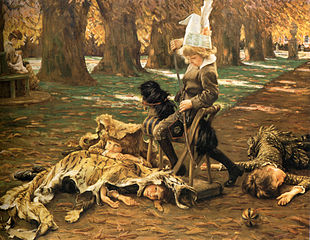
* James Tissot, A Little Nimrod(1882) (Tissot’s paintings are often overshadowed by a veil of disquietness despite their seemingly idyllic setting. The innocent child-play depicted slowly creeps into a Lord of the Flies-esque malice. Three children feign prostrate under the defeat of the victor, who draws a sword ready for another bout of ruthless slaying. The distorted body of the child on the right makes the game seem more realistic than playful, the mother, however, is moved to a rear end to prevent from witnessing the imminent dreadful outcome.)
Little Jim dreads to tell everyone that he has left little John on the playground. A surprise little Jim initially intended to plan yet when the dusk sets in his fear rises, rises like the sunset-red that seems to emerge amid the coming darkness, only one knows that the redness is doomed to fade away. Little Jim could feel the dusts gathering around his feet when he sped away from little John, who was obviously too engrossed in his picture books to notice any anomaly. Little Jim escaped from his escapade astonishingly easy- his folks welcomed him with outstretched arms and questioned him everything except little John’s questionable disappearance. There comes moments when the crimson encroach the egg-white on the sky, and other days when the colours just mingle and each thus diluted. Time whiles away like particles of dusts that one can surely assume they wear off gradually from a larger object. Little John is eternally forgotten.
There is a place when one fears to tread upon. Memories build a monument that ever stands erect on the exact place Jim, now a grown man, fears to set foot. That place, however, haunts incessantly the most fitful dreams of Jim. The monument just stands there motionless, wherever the dreams tend to. Perhaps one day Jim will go back to the playground and prepare himself to discover nothing but masses of dust. Those dusts have been swirling all over the place, washing over him without noise. The only hindrance is when a pellet of dusts chokes his breath, prevents him from furthering things he has yet to say. So what motivated Little Jim to leave Little John behind? What happened later when Little Jim announced his brothers’ disappearance? In his bouts of dreams Jim can still hear Little John leafing through picture books, the sound swishes just like walking on leaves. Leaves scatter in compliance to the winds, which also sweep along the gathering dusts. Dusts caress the leaves tenderly.
A little boy basks under the sunshine, burying his tiny head in a picture book. The boy is obviously seized by the pastel pictures of a young knight, who kills all the most horrible monsters and returns with glory. The book tells the traditional story of battle, defeat and victory. Dusk approaches yet the little boy is ever intrigued by the still next page. He studies each picture with great attention, being careful not to miss even the most inconsequent detail. The dense darkness gradually erodes the pages, and the little boy pulls the book closer before his very eyes with his little pudgy fingers. Now a shrill breaks out in the wilderness where the young knight is all-armoured to face his most testing enemy. The little boys’ wondrous eyes flicker when the knight raises his scintillating sword. Before long the battle will be won and the commotion will be appeased. Someone walks through the erect steles and remember the sound, the sound of the day when the dusts and the leaves call home.
Comments
Post a Comment